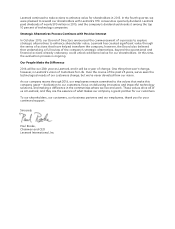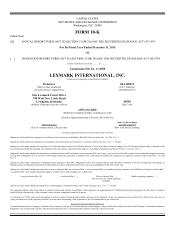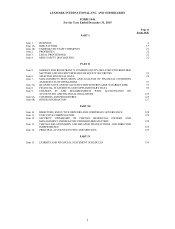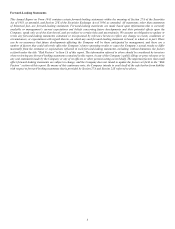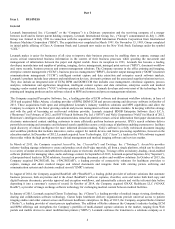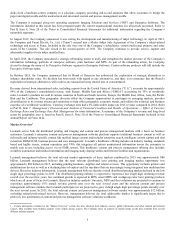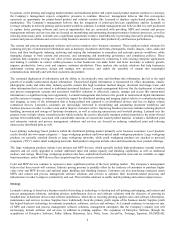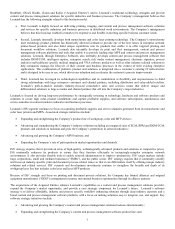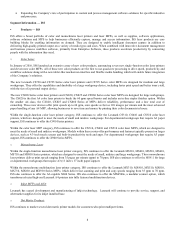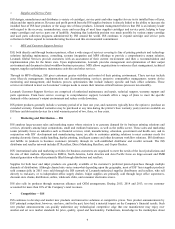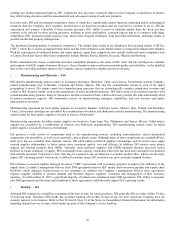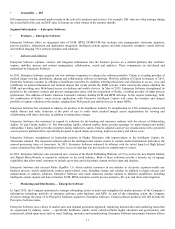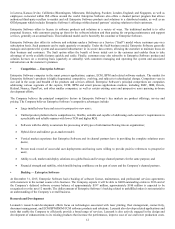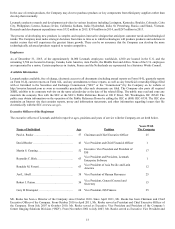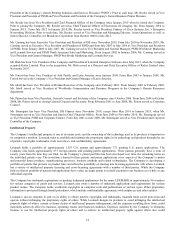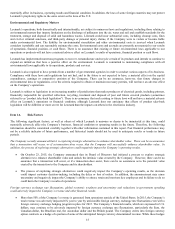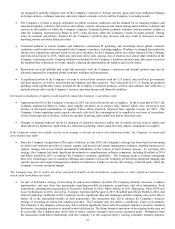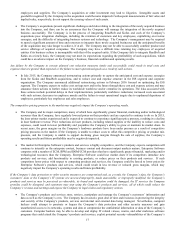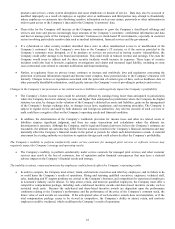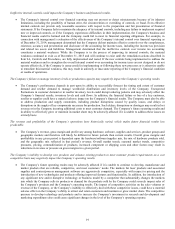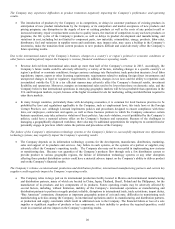Lexmark 2015 Annual Report Download - page 14
Download and view the complete annual report
Please find page 14 of the 2015 Lexmark annual report below. You can navigate through the pages in the report by either clicking on the pages listed below, or by using the keyword search tool below to find specific information within the annual report.10
pending new product announcements by ISS’ competitors may also have a material impact on the Company as purchasers of printers
may defer buying decisions until the announcement and subsequent testing of such new products.
In recent years, ISS and its principal competitors, many of which have significantly greater financial, marketing and/or technological
resources than the Company, have regularly lowered prices on hardware products and are expected to continue to do so. ISS has
experienced and remains vulnerable to these pricing pressures. ISS’ ability to grow or maintain market share has been and may
continue to be affected by these pricing pressures, resulting in lower profitability. Lexmark expects that as it competes with larger
competitors, ISS’ increased market presence may attract more frequent challenges, both legal and commercial, including claims of
possible intellectual property infringement.
The distributed printing market is extremely competitive. The market share leader in the distributed laser printing market is HP Inc.
(“HP”), which has a widely-recognized brand name and has been identified as the market leader as measured in annual units shipped.
With the convergence of traditional printer and copier markets, major laser competitors now include traditional copier companies such
as Canon, Ricoh and Xerox. Other laser competitors include Brother, Konica Minolta, Kyocera, Okidata and Samsung.
Refill, remanufactured, clones, counterfeits and other compatible alternatives for some of ISS’ toner and ink cartridges are available
and compete with ISS’ supplies business. However, these alternatives may result in inconsistent quality and reliability. As the installed
base of laser and inkjet products matures, the Company expects competitive supplies activity to increase.
• Manufacturing and Materials — ISS
ISS operates manufacturing control centers in Lexington, Kentucky; Shenzhen, China; and Geneva, Switzerland; and has company-
owned manufacturing sites in Boulder, Colorado and Juarez, Mexico. ISS also has customization centers in each of the major
geographies it serves. ISS retains control over manufacturing processes that are technologically complex, proprietary in nature and
central to ISS’ business model, such as the manufacture of toner and photoconductors. ISS shares some of its technical expertise with
certain manufacturing partners, many of whom have facilities located in China, which collectively provide ISS with substantially all of
its printer production capacity. ISS continually reviews its manufacturing strategies, capabilities, and cost structure and makes
adjustments as necessary.
Manufacturing operations for laser printer supplies are located in Boulder, Colorado; Juarez, Mexico; Zary, Poland; and Shenzhen,
China. Laser printer cartridges are assembled by a combination of in-house and third-party contract manufacturing. The manufacturing
control center for laser printer supplies is located in Geneva, Switzerland.
Manufacturing operations for inkjet printer supplies are located in Lapu-Lapu City, Philippines and Juarez, Mexico. Inkjet printer
supplies are assembled by a combination of in-house and third-party manufacturing. The manufacturing control center for inkjet
printer supplies is located in Geneva, Switzerland.
ISS procures a wide variety of components used in the manufacturing process, including semiconductors, electro-mechanical
components and assemblies, as well as raw materials, such as plastic resins. Although many of these components are standard off-the-
shelf parts that are available from multiple sources, ISS often utilizes preferred supplier relationships, and in certain cases single
sourced supplier relationships, to better ensure more consistent quality, cost and delivery. In addition, ISS sources some printer
engines and finished products from OEMs. Typically, these preferred suppliers and OEMs maintain alternate processes and/or
facilities to ensure continuity of supply. ISS occasionally faces capacity constraints when there has been more demand for its products
than initially projected. From time to time, ISS may be required to use air shipment to expedite product flow, which can adversely
impact ISS’ operating results. Conversely, in difficult economic times, ISS’ inventory can grow as market demand declines.
ISS continues to execute supplier managed inventory (“SMI”) agreements with its primary suppliers to improve the efficiency of the
supply chain. Lexmark’s management believes these SMI agreements improve ISS’ supply chain inventory pipeline and supply chain
flexibility which enhances responsiveness to our customers. In addition, the Company’s management believes these agreements
improve supplier visibility to product demand and therefore improve suppliers’ timeliness and management of their inventory
pipelines. As of December 31, 2015, a significant majority of printers were purchased under SMI agreements. ISS’ ability to negotiate
new SMI agreements and the terms and conditions of those agreements could adversely impact ISS’ operating results.
• Backlog — ISS
Although ISS experiences availability constraints from time to time for certain products, ISS generally fills its orders within 30 days
of receiving them. Therefore, ISS usually has a product backlog of less than 30 days at any one time, which the Company does not
consider material to its business. Refer to Part II, Item 8, Note 12 of the Notes to Consolidated Financial Statements for information
regarding deferred service revenue, which makes up most of the Company’s service backlog.


